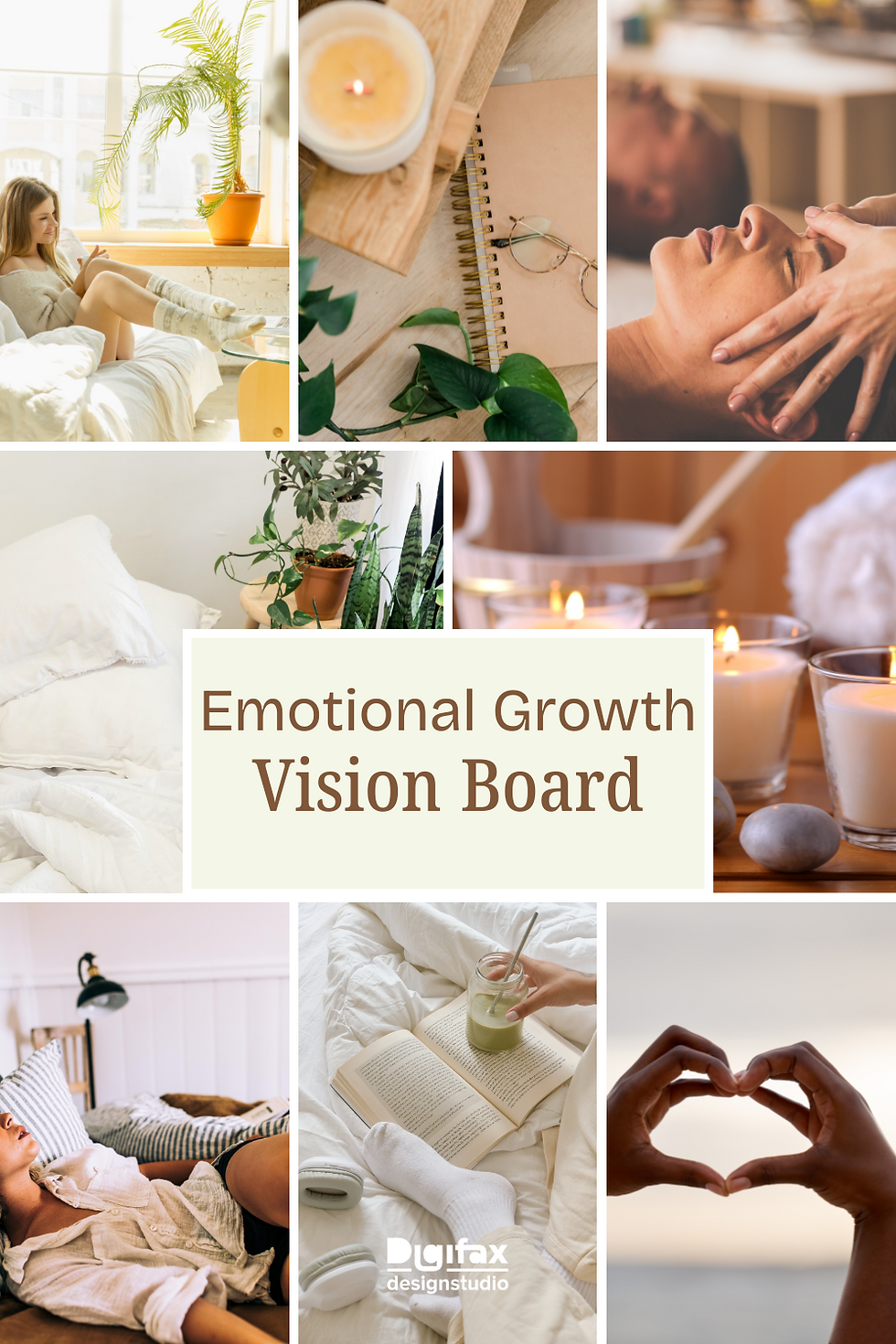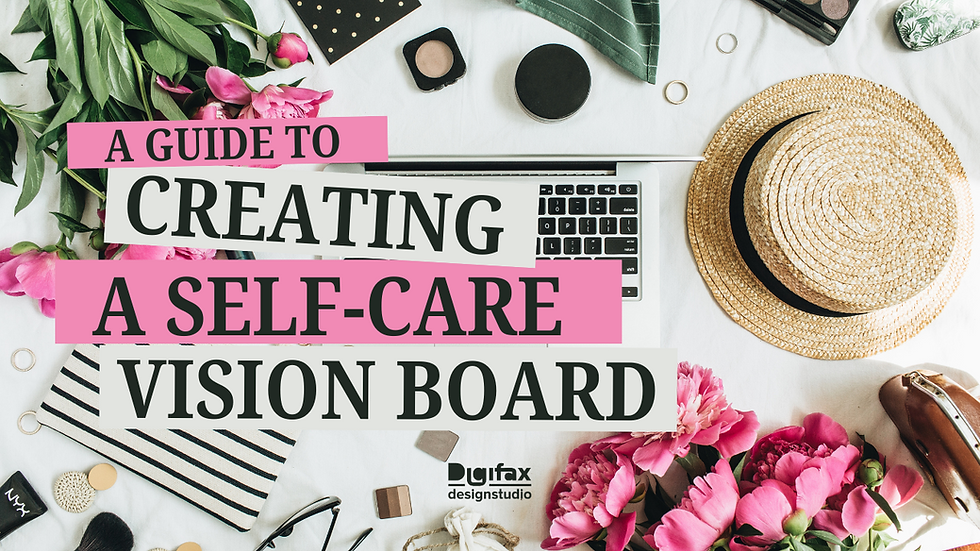Your Guide to Building a Mental Health and Self-Care Vision Board for 2025
- Megan Brewer
- Dec 30, 2024
- 5 min read
Updated: Jan 1

As we step into a new year, it’s the perfect time to set intentions that prioritize our mental health and self-care. A vision board isn’t just about visualizing success; it’s about creating a tangible reminder of the goals, habits, and feelings you want to cultivate in your life.
For 2025, let’s focus on building a vision board that inspires balance, growth, and inner peace.

Here is your 5 step guide to crafting a mental health and self-care vision board that works for you (remember to make any chances that best fit your mental health needs):
Step 1: Define Your Goals
Start by asking yourself these reflective questions:
How do I want to feel this year?
What areas of my life need more attention and care?
What habits or practices bring me joy and calmness?

Take a moment to journal your answers. For example, you might realize you want to feel more grounded, less stressed, or more connected to loved ones. Write these intentions down clearly so they become the foundation of your vision board.
Instead of vague goals like Be Happier, translate them into actionable intentions such as Create more time for hobbies or Practice gratitude daily.
Your vision board should reflect feelings and intentions, not just achievements.
For example, instead of focusing solely on Exercise more, you might include visuals that represent - Feeling strong, Moving joyfully, or Spending time in nature.
This shift ensures your goals align with your mental and emotional well-being.
Step 2: Choose Your Categories
To make your vision board intentional, divide it into categories that resonate with your mental health and self-care journey.
Here are some ideas to get you started:

Rest & Relaxation: Representing sleep, downtime, and recharging. This could include visuals like a cozy bed, a steaming cup of tea, or calming nighttime routines.
Healthy Habits: Including nutrition, movement, or mindfulness. Find images that represent eating nourishing meals, engaging in joyful physical activity, or meditating.
Boundaries: Visuals that remind you to say no or prioritize yourself. Add empowering quotes like "No is a complete sentence" or images of calm, clear spaces.
Joy & Celebration: Highlighting hobbies, laughter, and connection. Use images of dancing, laughing with friends, or pursuing creative projects.
Emotional Growth: Words or images representing resilience, gratitude, and self-compassion. Think about affirmations like "I am enough" or visuals of a blooming flower symbolizing growth.
Mindfulness: Focusing on being present and grounded in the moment. Include serene landscapes, yoga poses, or symbols of nature to inspire calm and presence.
Choose categories that reflect the areas of your life where you’d like to experience positive change. You can add as many or as few as you like, but aim for a balance that feels manageable and meaningful.
Step 3: Gather Your Supplies
Here’s what you’ll need to bring your vision to life:

A board: Corkboard, poster board, or even a digital canvas. Choose whatever format feels most accessible and inspiring to you.
Magazines or printouts: Collect images, quotes, and words that inspire you. Look for magazines that align with your interests—health, travel, mindfulness, or creativity.
Scissors and glue/tape: For assembling your masterpiece. If you prefer a digital approach, use tools like Canva to create your vision board.
Markers or pens: To add personal touches or write affirmations that resonate with you.
Optional: Stickers, washi tape, or other decorative elements to make your board uniquely yours.
Set up a calm, clutter-free space to work in. Light a candle, play soothing music, and make the process an act of self-care in itself. Gathering your supplies can be a fun and creative way to ease into the project and set the tone for intentionality.
Step 4: Assemble Your Vision Board
Start with a Clean Space: Clear your workspace and take a few deep breaths to center yourself. Approach the activity with a calm and focused mindset.
Organize by Categories: Arrange your images and quotes into sections based on the categories you chose. For example, group all "Mindfulness" items together or place "Joy" in a prominent corner of the board.
Layer and Personalize: Add decorative elements like stickers or washi tape, write affirmations, or use colors that evoke calm and joy. Let your creativity shine.
Be Intentional: Place the most meaningful images and words in prominent positions to draw your attention. If "self-compassion" is your focus, ensure it stands out on the board.

This process isn’t about perfection—it’s about creating something that resonates with you. Take your time, rearrange elements if needed, and enjoy the journey of self-discovery.
Step 5: Display Your Vision Board
Place your vision board somewhere you’ll see it daily—your bedroom, office, or even as your phone wallpaper if it’s digital. This visibility serves as a daily reminder of your intentions and helps keep you focused on your mental health and self-care priorities.
Consider creating a small ritual around your vision board. Spend a few moments each morning reflecting on it, or use it as a journaling prompt to check in with yourself throughout the year. This practice can help reinforce your intentions and keep you aligned with your goals.
Tips for a Mental Health-Focused Vision Board

Focus on Feelings: Instead of just "to-do" goals, think about how you want to feel. For example, include images of serene landscapes to evoke peace.
Use Affirmations: Incorporate phrases like "I am worthy of rest" or "Boundaries are self-care" to reinforce positive beliefs. These affirmations can help reframe your mindset and build self-confidence.
Keep It Simple: A cluttered board can feel overwhelming. Choose a few meaningful elements that truly resonate with you, rather than filling every inch if that is what works best for you.
Revise as Needed: Your vision board isn’t set in stone. Feel free to add or update it throughout the year as your goals and needs evolve. Life changes, and your vision board can change with it.
Why Vision Boards Work for Mental Health
Creating a vision board is a therapeutic exercise. It allows you to:
Visualize your intentions and goals. Seeing your goals visually can make them feel more tangible and achievable.
Reflect on what’s truly important to you. The process helps you clarify your values and prioritize what matters most.
Cultivate mindfulness as you engage in a creative process. Focusing on images, words, and designs can feel meditative and grounding.

Make 2025 Your Year of Mindful Growth
Your mental health and self-care vision board is more than just an art project—it’s a tool for setting intentional goals and staying grounded throughout the year. Take your time, make it personal, and remember: It’s about progress, not perfection.
💬 Have you created a vision board for 2025?
Share your favorite elements or tips in the comments below!
References
Very Big Brain. (2024, October 03). The Role of Visualization in Achieving Personal Goals. Very Big Brain. https://verybigbrain.com/body-brain-connection/the-role-of-visualization-in-achieving-personal-goals/#:~:text=and%20effective%20visualizations.-,Incorporating%20Visualization%20into%20Daily%20Routines,also%20help%20reinforce%20positive%20habits%20and%20behaviors%20for%20the%20next%20day.,-Making%20visualization%20a


Comments